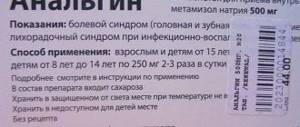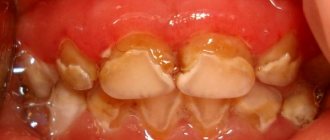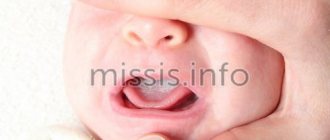The best gel for teething: Dentinox, Kamistad, Kalgel or Cholisal
From about six months of age, the baby begins to erupt his first teeth - the front row, the lower jaw. In addition to the direct growth of teeth, you can observe:
- Sleep disturbances, frequent whims and awakenings for no reason at night
- Gums become inflamed, red, and swollen
- The child takes everything in his mouth and chews
- Body temperature can rise to 38 degrees, but lasts no more than three days
- The baby becomes nervous and refuses to eat.
The best method of symptomatic treatment of an erupting tooth is the use of modern gels. These drugs contain an anesthetic that, when applied locally, relieves pain without penetrating into the systemic bloodstream. Also, if the gel is good, then in addition to the anesthetic, its composition should include softening and anti-inflammatory components, and antiseptics.
Dentinox or Kamistad?
Dentinox is a transparent homogeneous substance with a yellowish tint.
The smell is menthol with notes of chamomile. If you use dentinox in advance for preventive purposes before the expected tooth eruption, you can avoid the painful consequences of eruption. Dentinox prevents inflammation of the mucous membrane, the occurrence of stomatitis, and pain during further tooth growth. The composition contains active substances - chamomile flower extract, lidocaine, polidocanol. Auxiliary components – sorbitol, xylitol, saccharin, levomenthol. The drug can be prescribed from the age of four months. Dentinox is contraindicated in the presence of open wounds in the mouth, and in people with hypersensitivity to fructose. Possible side effects in the form of a local allergic reaction, itching, rash, swelling.
Find out more about Dentinox analogues here.
Kamistad - can be used from the age of three months, but with caution and under the supervision of a doctor, since the content of lidocaine in it is high. Without the supervision of a specialist, Kamistad can be used from the age of 12. It contains two active ingredients - lidocaine hydrochloride and chamomile flower tincture. Additionally it contains sterile water, sodium saccharin, benzalkonium chloride, carbomers.
The advantage of the drug is that side effects are rare. They usually manifest themselves as redness and a burning sensation in the gums. Contraindications include hypersensitivity to the components of the gel and children under 3 months of age.
What is better to choose – Cholisal or Kalgel?
These two medications are the most popular among all others in the category of dental gels, so they need to be examined in detail and compared.
Cholisal contains active ingredients – choline salicylate and cetalkonium chloride, which effectively eliminate swelling and inflammation. Due to the direct effect on the cause of pain, the discomfort disappears after 2-3 minutes, and the duration of the effect is at least eight hours in a row. The drug has a wide range of uses and can be used for stomatitis, gingivitis, periodontal disease, and oral candidiasis. When teething, it can be used in children from 1 year of age. Read also: How to take analgin for toothache Kalgel is prescribed to children from 5 months, the active ingredients are the analgesic lidocaine and the antimicrobial cetylpyridinium chloride. With prolonged use, it can cause allergies, and also has many contraindications: intolerance, hypersensitivity, heart failure of 2 and 3 degrees, low blood pressure and renal and liver failure.
Which of these drugs is better? Depends on the specific situation. Kalgel can be prescribed from 5 months, and Cholisal only from 1 year. The price category for these drugs is the same. Kalgel has a sufficient number of contraindications; it can also cause an allergic reaction. Cholisal is safer in this regard - the only contraindications are individual intolerance, and the side effects are local tingling and itching.
How to help if you are teething?
Try this:
- Don't get angry with your baby and don't yell, even if he doesn't let you sleep for several nights.
- Rule out serious illnesses.
- Spend more time with your child: rock him, play with him, distract him with toys.
- Feed your baby on demand in a timely manner if he asks for breastfeeding or formula more often: he loses more water with saliva and diarrhea, which is detrimental to his body.
- Buy a teether, preferably filled with water. You can keep it in the refrigerator for a while, and by cooling your gums, it will reduce the discomfort in them. Instead of a teether, you can use a pacifier, which can also be slightly cooled.
- If the tooth is cutting for a long time - without fever, but with pain and itching, during which the baby gnaws on everything, go to the dentist. Sometimes the doctor only needs to make a small incision on the gum, this will be the answer to the question “when teeth are cutting, how to help.”
- You can treat your gums with a 1% soda solution (1 teaspoon per 1 liter of boiled water). It alkalizes the local pH of the tissue, which has deviated to a more acidic side due to inflammation. Consequently, inflammation, and along with it pain, will decrease. To help your child with baking soda, take sterile gauze, wrap it around your finger, dip it in the solution and treat the gums. It is not recommended to rub either inflamed or healthy areas of the oral mucosa with soda crystals.
In order to understand how to anesthetize teething teeth, you should pay attention to two approaches - systemic and local.
Taking systemic medications
These are painkillers in the form of suspensions, injections and suppositories. In medicine, they are called non-steroidal anti-inflammatory drugs, or NSAIDs for short. They work as follows: when absorbed into the blood in the intestines, they suppress the production of the enzyme cyclooxygenase in the body. Since this enzyme helps in the synthesis of substances “responsible” for pain and inflammation, its inhibition reduces the severity of the inflammatory process and pain syndrome.
Non-steroidal anti-inflammatory drugs in the form of systemic drugs act on the entire body, providing positive effects. They not only reduce pain, but also lower temperature, and, due to inhibition of inflammation, somewhat reduce intoxication. NSAIDs existing in the form of a suspension can be taken by children from 1–2 months of age.
Of course, systemic anti-inflammatory drugs “know” how to relieve pain if teething, but some of them can cause the following side effects:
- cause inflammation in the gastric mucosa, increasing the risk of formation of erosions and ulcers on it, which can bleed (acetylsalicylic acid);
- affect blood cells (acetylsalicylic acid, paracetamol, metamizole sodium);
- increase the risk of venous thromboembolism.
An overdose of, for example, acetylsalicylic acid can lead to acute renal failure with impaired function of the main working units of the kidney - its tubules. In addition, it can cause liver and brain damage - life-threatening Reye's syndrome.
Therefore, if the child is older than one year and teething occurs without fever, it is better not to resort to pain relief with systemic NSAIDs.
Why is it better than Kamistad + Experience of use in children and adults (Photo)
Our first birthday was overshadowed by the fact that our daughter developed a “teething cyst” on one of her teeth. This is an abscess on the gum associated with the eruption of a tooth, which for some reason cannot come out in time and, due to stagnation in the gum, an inflammatory process occurs. I was shocked, since all previous teeth erupted without such problems. Dentists opened this abscess, within 2 days a tooth quickly emerged from this place, but the gum was very painful, it was swollen, my daughter experienced discomfort, and did not sleep well at night.
I started smearing my gums with the legendary Kamistad, which is in every young mother’s medicine cabinet, but it didn’t really help. Then I called the doctor, and he prescribed the dental gel Cholisal , explaining that Kamistad only relieves pain, and Cholisal, in addition to relieving pain, has an anti-inflammatory effect. In other words, Cholisal eliminates the cause and source of pain, therefore, for more serious problems than ordinary teething, Kamistad is much more effective. Therefore, it is also used for stomatitis and even injuries to the oral mucosa.
About the product: It is a classic transparent gel only with a more viscous consistency. It has a non-pungent anise aroma, which reminds me very much of the smell of a treatment room from my Soviet childhood. The taste is bittersweet. When applied, a quick-passing burning sensation of the gums is first noted.
Result of use in children: After anointing the child’s sore spot with Cholisal for several days, I saw positive dynamics - the pain went away, the swelling subsided, my daughter became cheerful and calm again, and stopped “getting into” her mouth. We didn’t go for a follow-up appointment with the dentist because there was no need. He also cured my child’s stomatitis in a few days, which the useless Solcoseryl dental paste could not cope with. Now (I’ll add to the review) my daughter is already seven years old, the active replacement of baby teeth has begun. The eruption of permanent teeth is accompanied by discomfort, and we, based on our first experience, also resort to the services of Kholisal, which removes this unpleasant discomfort in a short time.
Experience of use in adults: I myself started having problems with my gums. Between the sixth and seventh upper teeth, a so-called gum pocket formed, that is, a depression into which fibrous food constantly fell, which had to be difficult to remove using dental floss. These manipulations severely injured the gums, causing inflammation and bleeding of the gums, accompanied by an unpleasant aching pain. The doctor prescribed me Metrogyl Denta , but it did not solve my problem. Then I decided to anoint the inflamed gum with my daughter’s Cholisal. And, lo and behold! Cholisal was very gentle and quickly healed my inflamed gums. Only now Cholisal has become available in a different package, but this has not affected its properties in any way.
Read also: Pain reliever for children under one year old
Conclusion: Holisal helped me and my daughter more than once. First, at one year old, when problems arose during the eruption of the first teeth. By the way, the rest of the teeth came out without any problems. Kamistad has not been used since then; they trusted Cholisal as a more powerful remedy. We had another dental gel - Kalgel , I have never seen a more useless product, it’s still just lying around in the medicine cabinet. Now, at an older age, we use Cholisal again during the change of milk teeth to permanent ones. As it turned out, Holisal also copes well with “adult problems”; it helped me a lot in treating inflamed gums.
When to suspect teething
The first teeth - the lower central incisors - can begin to erupt as early as three months, but in most cases their time comes at the age of 6-7 months.
Starting from this age, when symptoms appear that make it possible to suspect a cold or intestinal infection (we will talk about them later), first of all you should think about the fact that it could be teething and how to help the baby. Only after providing pain relief assistance, call a doctor and examine the child as prescribed. Teething occurs approximately according to this schedule:
| What kind of teeth | Time of eruption of baby teeth (months) | |
| Incisors | Lower central | 6–7 |
| Upper central | 8–9 | |
| Upper side | 9–11 | |
| Lower side | 11–13 | |
| Indigenous | The first (immediately behind the fangs) upper | 12–15 |
| First top | 12–15 | |
| Second (large) bottom | 24–30 | |
| Second top | 24–30 | |
| Fangs | Upper | 16–18 |
| Lower | 18–20 | |
It is especially important to know how to numb teething teeth in the following cases:
- at the age of 16–20 months, when the fangs grow: these are the teeth whose eruption is worst tolerated by children;
- if the first incisors began to appear closer to 11–13 months: the baby may have problems with the jaw bones, so any teeth he develops will be very painful;
- if the child was already born with defects of the dental-jaw system.
Holisal or Kamistad?
The compared medications that are actively used in dentistry are painkillers and anti-inflammatory gels. They are applied directly to the oral mucosa and are safe for use except in cases of allergies. Cholisal and Kamistad are interchangeable treatment options, despite the fact that their composition and some features of use differ. The easiest way would be to consider the pros and cons of using these gels for adults and children.
Differences in indications and use
Both dental gels are used to relieve inflammation and reduce pain in damaged oral mucosa (stomatitis, periodontitis, gingivitis). Comistad - a German-made gel exhibits a better analgesic effect, Cholisal has a more pronounced antiseptic and anti-inflammatory effect (produced in Poland and Russia), is indicated for a wider range of problems with the oral mucosa, in which its competitor is not used, namely:
- candidiasis (“thrush” of the mouth),
- lichen planus (itchy dermatosis localized in the mouth),
- Stevens-Johnson syndrome (not as a primary, but as an auxiliary remedy).
In children's forms, Cholisal and Kamistad are used for teething. “Adult” Kamistad is not recommended for these purposes due to the lidocaine content, but the line has a special form Kamistad Baby, which does not contain lidocaine, so it is better to use it. For a child, it is enough to squeeze out a little gel (about half a centimeter) onto a cotton swab or clean finger and rub lightly into the gums 2-3 times a day. “Children’s” Cholisal is used with the same frequency and in the same quantities, preferably before feeding and/or before bedtime.
Read also: Is kamistad possible for children under one year old?
What symptoms indicate that teeth are being cut?
The first reason to pay attention to whether teeth are cutting, and how to help determine it, are the general symptoms:
Behavior change
The child either pushes his parents away or asks to be held. He often cries, refuses his favorite toys or pacifiers, and throws them on the floor.
In addition, the baby loses his appetite. When starting to eat, the child feels discomfort in the teething area, so the baby eats in small portions, and, having started to eat, cries after a short period of time. Sleep is disturbed: pain in the gum prevents him from falling asleep.
Most children indirectly show that they are teething, and every parent should know how to help. They:
- chew any hard objects they can reach;
- often reach for the breast or bottle, while hardly eating, but rolling (or gnawing) the nipple or pacifier in the mouth.
In general, it is worth considering that teeth are being cut and how to help with this if the baby has become “unbearable” for no apparent reason.
Please note: these symptoms should not last longer than two to three days and should end with the appearance of a small area of tooth above the gum.
Increased salivation, chin irritation and wet cough
These are interrelated symptoms:
- Salivation increases as a result of three reasons:
- irritation of the gum tissue and the nerve endings located in it by the erupting tooth;
- physiologically - due to the baby adopting a new position for him - sitting, which coincides with teething;
- difficulty swallowing saliva.
- A wet cough is a consequence of a large amount of saliva. The baby still lies more often than sits, so saliva flows down the back wall of the throat and enters the respiratory tract. If the cough is caused specifically by teething, it occurs in the morning and is almost not observed during the day when the child is awake.
- Redness and rash on the chin also occur due to the abundance of saliva that flows onto the skin.
If you see such signs of teething in your child, how to relieve pain, read on.
Runny nose
The appearance of light, watery discharge from the nose is possible due to teething. This type of runny nose may be accompanied by sneezing, but ends within 3-4 days without complications. If the snot becomes yellow or green, or the cough gets worse and the child becomes lethargic, check with your pediatrician. In such a situation, the question “how to numb teething teeth”, as a rule, does not arise.
Changing the appearance of your gums
2–3 weeks before the eruption of a canine, incisor or molar, an enlarged blue area (hematoma) may appear on the gum. This is not accompanied by unpleasant symptoms, and the child behaves as usual.
A change in the appearance of the gums when the symptoms described above appear helps to understand that teeth are being cut and how to help - this is the most important question at the moment. In this case, the gum becomes reddish and swollen; touching it causes discomfort in the child and a desire to bite the object being touched. These local signs disappear after the tooth appears above the gum. Sometimes teething is accompanied by the release of a small amount of blood.
Controversial symptoms
Often, against the background of the eruption of incisors, canines or molars, the child experiences symptoms that are very reminiscent of some kind of infection - respiratory or intestinal:
- temperature rise above 37.5°C
- diarrhea;
- vomit;
- pain in the ear or maxillary sinus;
- lethargy.
Both the parents themselves and the pediatrician can associate these signs with teething. But in fact, the child needs examination. Because teething often coincides with ARVI or intestinal infection.
This is justified: immunological studies prove that immunity decreases physiologically during this period. That is, if previously a child could easily cope with a pathogenic microbe, now it is difficult to resist it.
To understand whether it is an infectious disease or teething and how to help, an examination by an ENT doctor is often enough. After examining the throat, nose and ears, he will tell you whether there are signs of inflammation there or not. If the ENT organs are in order, perhaps such symptoms are still associated with a dental problem.
Diarrhea that occurs against the background of teething requires consultation with an infectious disease specialist. Especially if loose stools are observed more than 3 times a day or are accompanied by an increase in temperature.
Difference in composition and action
The main difference in the composition of the compared drugs, which you should pay attention to first of all, is the presence of lidocaine
in Kamistad for adults.
In dentistry, it is used in local anesthesia, but this is not done too often or without prior testing (first application in a small amount). The main soothing active ingredient is a completely harmless chamomile
. In addition to lidocaine, formic acid can also be found in the medicine, albeit as just an auxiliary element. Due to its fast and fairly strong anesthetic effect, Kamistad may be a more suitable option for severe pain.
Despite the fact that Cholisal does not contain lidocaine, it also relieves pain quite effectively. The main active ingredients are cetalkonium chloride
and
choline salicylate
anhydrous. The first component disinfects the surface of the mucous membrane (antiseptic effect), the second has an analgesic and “calming” effect on irritation (anti-inflammatory effect). Among the ingredients that distinguish it from its rival, which are worth paying special attention to, are anise oil and ethyl alcohol. Although the oil is only an auxiliary substance, the amount of which is small, its presence is still important for people with allergies (the same goes for chamomile extract in the opponent).
In the Cholisal line there is also a variant of Cholisal Dental, produced in one and a half times larger volume (15 g). It contains peppermint oil and propylene glycol. It is indicated not only for inflammation and infectious infections, characterized by irritation and swelling of the oral mucosa, but also in the case of ulcerative and purulent processes. Does not contain sugar. Otherwise, the composition does not differ from regular Kholisal. In general, this option is preferable if you choose what is best for stomatitis.
Gels are applied 2-3 times a day before meals (if it hurts to chew) or after (after rinsing your mouth), as well as before bed.
The difference in shelf life is almost double - Kholisal has a shelf life of 3 years, Kamistad 5 years (although tubes of 10-15 g are unlikely to last that long). Both should be kept away from heat sources and not exposed to sunlight.
Neither one nor the other gel should be cooled or even frozen, even if you want to enhance the analgesic effect with coolness - this will negatively affect the effectiveness of the components.
What to choose?
The decision which is better - Cholisal or Kamistad, primarily depends on the purpose and degree of pain. When teething, children's forms of both are suitable; Kamistad's composition is more “natural” in this regard, the main thing is to make sure that the child is not allergic to chamomile.
For adults with inflammatory processes in the oral cavity, it is better to choose Cholisal (regular or Dental), since its composition is more focused on disinfecting and relieving inflammation.
Sources:
https://lekhar.ru/lekarstva/stomatologicheskie-sredstva/holisal-ili-kalgel-chto-luchshe/ https://irecommend.ru/content/chem-luchshe-kamistada-foto https://mymednews.ru/holisal -ili-kamistad/
Comparison of addiction between Kamistad and Kholisal
Like safety, addiction also involves many factors that must be considered when evaluating a drug.
So, the totality of the values of such parameters as “o syndrome” in Kamistad is quite similar to the similar values in Kholisal. Withdrawal syndrome is a pathological condition that occurs after the cessation of intake of addictive or dependent substances into the body. And resistance is understood as initial immunity to a drug; in this it differs from addiction, when immunity to a drug develops over a certain period of time. The presence of resistance can only be stated if an attempt has been made to increase the dose of the drug to the maximum possible. At the same time, in Kamistad the meaning of the “syndrome” is quite small, however, the same as in Kholisal.










